小学英语四年级复习提纲
- 格式:doc
- 大小:43.50 KB
- 文档页数:2

外研社版三起小学英语四年级上册M M复习提纲四年级上册M1-M10复习提纲Module 1重点单词1.left 左边2. right 右边3. straight 直地4. lost 迷路5.live 居住6. street 大街,街道7. road路8. station车站9.house 房屋10. supermarket 超市11. cinema 电影院12. hill 小山 13. train 火车 14. near 接近,临近15.so much 十分,非常 16. next to 紧挨着,临近17. You’re welcome 不客气18. beside 在……旁边,在……附近 19. NO. 第…..号重点短语1. behind the tree 在树后2. on your left在你的左边3. turn left 向左拐4. turn right向右拐5. go straight on直走6. Excuse me 对不起,打扰了7. beside the cinema 在电影院旁边8. up the hill 上山9. down the hill下山 10. at the station 在车站 11. near the house在房子附近 12. next to the supermarket 紧挨着超市重点句子1.Where is the train?火车在哪里It’s up the hill. 它在爬山。
2. I live at No.2,Park Street. 我住在公园街2号。
3. Thank you so much 非常感谢。
You’re welcome. 不客气Module 2重点单词1.read 读,阅读2. listen 听3. listen to 听4. talk 说话5. talk to 和……交谈6. take 拍摄 7. picture 照片8. running 跑步9. China 中国 10. child 小孩 11.children 孩子们 12.these 这些13. those 那些重点短语1. take pictures 拍照片2. talk to her friend.和朋友讲话3. play with a toy train. 玩玩具火车4. listen to music 听音乐5. watch TV 看电视6. read a book读书7. play basketball打篮球8. play football 踢足球9. fly a kite 放风筝 10. ride a bike 骑自行车 11. look at these pictures看这些照片重点句子1. This is my friend Maomao. 这是我的朋友毛毛2. What are you doing你正在干什么I’m reading a book. 我正在读一本书。
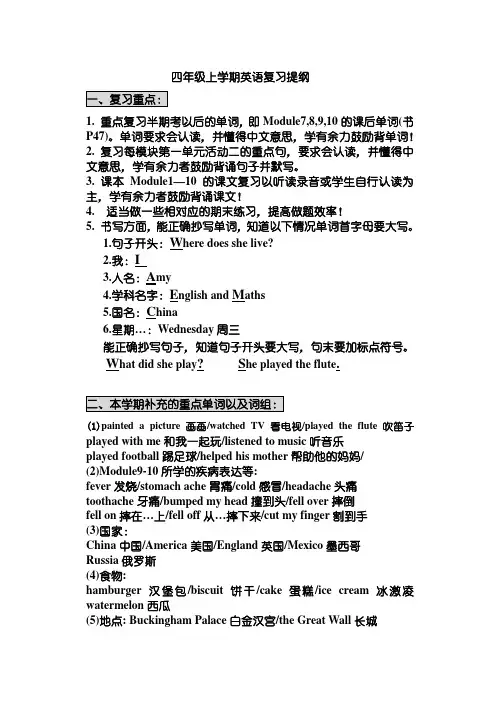
四年级上学期英语复习提纲1. 重点复习半期考以后的单词,即Module7,8,9,10的课后单词(书P47)。
单词要求会认读,并懂得中文意思,学有余力鼓励背单词!2. 复习每模块第一单元活动二的重点句,要求会认读,并懂得中文意思,学有余力者鼓励背诵句子并默写。
3. 课本Module1—10的课文复习以听读录音或学生自行认读为主,学有余力者鼓励背诵课文!4.适当做一些相对应的期末练习,提高做题效率!5. 书写方面,能正确抄写单词,知道以下情况单词首字母要大写。
1.句子开头:W here does she live?2.我:I3.人名:A my4.学科名字:E nglish and M aths5.国名:C hina6.星期…:Wednesday周三能正确抄写句子,知道句子开头要大写,句末要加标点符号。
W hat did she play?S he played the flute.(1)painted a picture画画/watched TV看电视/played the flute吹笛子played with me和我一起玩/listened to music听音乐played football踢足球/helped his mother帮助他的妈妈/(2)Module9-10所学的疾病表达等:fever发烧/stomach ache胃痛/cold感冒/headache头痛toothache牙痛/bumped my head撞到头/fell over摔倒fell on摔在…上/fell off从…摔下来/cut my finger割到手(3)国家:China中国/America美国/England英国/Mexico墨西哥Russia俄罗斯(4)食物:hamburger汉堡包/biscuit饼干/cake蛋糕/ice cream冰激凌watermelon西瓜(5)地点: Buckingham Palace白金汉宫/the Great Wall长城What’s the matter? What did you eat yesterday? 你怎么了?你昨天吃了什么?I have got a stomach ache. I ate chocolate biscuits.我吃了巧克力饼干。
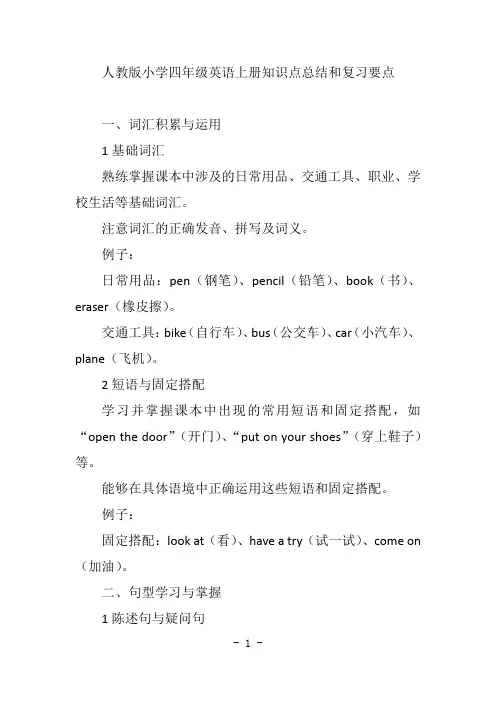
人教版小学四年级英语上册知识点总结和复习要点一、词汇积累与运用1基础词汇熟练掌握课本中涉及的日常用品、交通工具、职业、学校生活等基础词汇。
注意词汇的正确发音、拼写及词义。
例子:日常用品:pen(钢笔)、pencil(铅笔)、book(书)、eraser(橡皮擦)。
交通工具:bike(自行车)、bus(公交车)、car(小汽车)、plane(飞机)。
2短语与固定搭配学习并掌握课本中出现的常用短语和固定搭配,如“open the door”(开门)、“put on your shoes”(穿上鞋子)等。
能够在具体语境中正确运用这些短语和固定搭配。
例子:固定搭配:look at(看)、have a try(试一试)、come on (加油)。
二、句型学习与掌握1陈述句与疑问句熟练掌握陈述句和疑问句的基本结构,能够正确运用主语、谓语和宾语。
学会使用疑问句询问信息,如“What’s this?”(这是什么?)和“Where is your book?”(你的书在哪里?)。
例子:陈述句:I have a new pencil box.(我有一个新的铅笔盒。
)疑问句:Do you like playing football?(你喜欢踢足球吗?)2特殊疑问句学习并掌握“What color is it?”(它是什么颜色的?)、“How old are you?”(你多大了?)等特殊疑问句及其回答方式。
能够根据问题提供正确的信息。
例子:特殊疑问句:What do you usually do on weekends?(你周末通常做什么?)回答:I usually go to the park with my family.(我通常和家人去公园。
)三、语音与语调规则1元音与辅音发音复习并巩固元音和辅音的发音规则,注意发音的准确性和清晰度。
练习发音相近或容易混淆的词汇,提高发音敏感度。
发音练习:正确区分“thin”(瘦的)和“thing”(事情)的发音。

复习大纲Module11.have gothas got (has 为have 的第三人称单数)e.g I have got a new friend.He’s got long,black hair. (He’s 是He has的缩写)2.will+动词原型e.g I will be eleven year next year.3.星期的前面要用on,月份,年份前面要用inOn Saturday in April in 20014.注意介词的用法Write to me. Tell me about your friend. Thank you for your letter.5.like+doing I like dancing.Module2注意作文,可以利用下列句子。
(看到yesterday,last…要用过去式) I washed my trousers.I cleaned my room.I finished my homework.I watched TV.I painted a picture.I listened to music.I played the flute.I played basketball.Module 3注意第三人称(he,she,it,人名)做主语后面的动词要加s或es Lingling usually gets up at 7 on Mondays.提醒: 除了第三人称单数以外其他的动词要用原型考点:I usually walk to school on Mondays.She usually has English at school.I usually have English at school.Module 4注意方位词In在里面,on在上面,under在下面Between在两者之间beside在….旁边in front of 在…前面Module51注意名词变复数(5条)特别记忆child—children woman—women man—menLeaf—leaves注意fifty minutes lots of mountains some beautiful plants2.注意句子We went on a school trip yesterday.(go on aschool)We went skating. (go skating)It took us fifty minutes to climb to the top.(It took…to….)Module6.71.一般过去式的句子变否定句,didn’t+动词原型It didn’t become gold.She didn’t take the leaves away.2.一般过去式的一般疑问句,开头加Did后面动词还原成原型Did you take Amy’s doll?3.be(am,is,are)+v.ingI am reading a letter.Who is crying?Module8注意疑问词what(干什么),where(提问地点),when(提问时间)What did she play? She played the flute.When did they come? They came last Wednesday.Where did you go yesterday? I stayed at home.Module9What happened to you?(注意to)I bumped my head.I fell over. I hurt my knees.I cut my finger.Module101祈使句的学习,记住重点句子Take this medicine.Drink a lot of water.Go to bed early.Do some exercise.Eat vegetables every day.Drink lots of water or juice.Always wash your hands before you eat and after you go to the toilet.2.注意is ,areFruit is healthy.Vegetables are healthy.考试常出现的固定搭配1.It is a picture of the Great Wall.2.Here is a photo of my birthday party.3.We went on a school trip.4.We went skating.5.I was able to skate.6.The bad man went to sea in the ship.7.He took Ma Liang away.8.Did you look for it in your bag?9.He fell off his bike.10.D o you want to be healthy?。
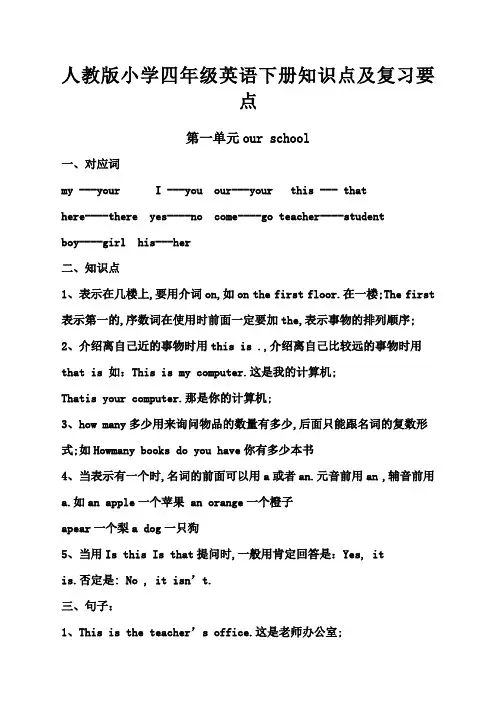
人教版小学四年级英语下册知识点及复习要点第一单元our school一、对应词my ---your I ---you our---your this --- thathere----there yes----no come----go teacher----studentboy----girl his---her二、知识点1、表示在几楼上,要用介词on,如on the first floor.在一楼;The first 表示第一的,序数词在使用时前面一定要加the,表示事物的排列顺序;2、介绍离自己近的事物时用this is .,介绍离自己比较远的事物时用that is 如:This is my computer.这是我的计算机;Thatis your computer.那是你的计算机;3、how many多少用来询问物品的数量有多少,后面只能跟名词的复数形式;如Howmany books do you have你有多少本书4、当表示有一个时,名词的前面可以用a或者an.元音前用an ,辅音前用a.如an apple一个苹果 an orange一个橙子apear一个梨a dog一只狗5、当用Is this Is that提问时,一般用肯定回答是:Yes, itis.否定是: No , it isn’t.三、句子:1、This is the teacher’s office.这是老师办公室;2、That is my classroom.那是我的教室;3、Go to the library. Read a story-book..去图书馆;读故事书;4、Is this the library Yes, it is.这是图书馆吗是的;5Isthat the art room The art room is on the second floor. 那是美术室吗不是,美术室在二楼;6、Whereis the canteenIts on the first floor.食堂在哪里在一楼;7、How many students are there in youclass Forty.数字8、 8、Let’s go and have a look 让我们去看一看;四、单词:playground garden library artroom light picture boardteachers'office gym TV room teacher’s desk wallfloor your computer fan this way ,please五、Go to the library ,read a book.Go to the teachers’ office, say hello.Go to the playground, play football.Go to the garden, water the flowers.复习知识点Unit 1A部分:computer计算机 board写字板 fan风扇light灯This is my computer.这是我的电脑;That is your computer.那是你的电脑B部分:teacher′s desk讲台picture图画;照片wall墙壁floor 地板Is this a teacher’s desk ——Yes, it is.第二单元:What time is it一、知识点1、同义词:supper ===dinner晚饭2、say第三人称单数 says have =has3、同义句:Whattime is it ===What’s the time现在几点了4、Let’s 后面直接跟动词的原形;如:Let’s go让我们走吧Let’s clean the classroom.让我们打扫教室吧5、It’stime for后面跟名词;如:It’s time fordinner.该吃晚饭了; It’s time for Englishclass.该上英语课了It’s time to 后面跟动词;如:It’stime to eat dinner.该吃晚饭了; It’s time to have English class.该上英语课了;二、句子:1、What time is it 几点钟了2、It’s nine o’clock.现在九点;3、It’s time for English class.该上英语课了;lunch English class musicclass breakfast dinner class4、School is over. Let’s go to the playground.放学了,让我们去操场吧5、It’s time to go to school.该去学校了get up go to school go to bed go home三、单词:lunch English class music class breakfast dinner class get up go to school go to bed go home just a minute 复数形式:foot----feet 脚四、It’s time for breakfast. Let’s drinksome milk.It’s time for lunch. Let’s have some chicken.It’s time for dinner. Let’s eat some rice.It’s time for PE class. Let’s jump and run.It’s time for English class. Let’s read and write.It’stime for music class. Let’s sing and dance.Unit 2复习知识点A部分:one一two二three三four 四five五six六seven七eight八nine九ten十What time is it ——It’s two o’clock.B部分:math数学Chinese语文English英语.体育music音乐class 课程It’s 9:45. It’s time for math class.第三单元weather一、知识点1.同义词:Howabout ===What about怎么样2、表示天气的几个形容词都是同是由相应的名词变化而来的,它们的对应形式是:名词形式形容词形式rain雨 rainy下雨的snow雪 snowy下雪的wind风 windy有风的cloud云 cloudy有云的sun阳光 sunny晴朗的3、一般疑问句Canyou 的回答形式有两种肯定回答是:Yes, I can. 否定回答是: No, I can’t.一般疑问句Can I 的回答形式也有两种肯定回答是:Yes, you can.否定回答是: No, you can’t.4、当问某个地方的天气如何时,要用What’s the weather like in +地名如:What’s the weather like in Beijing北京的天气怎么样二、单词cold cool warm hot sunny windy cloudy snowy rainy outside be careful weather New York degree world London Moscow Singapore Sydney fly loveUnit3复习知识点A部分:red红色的blue蓝色的yellow黄色的green绿色的white白色的Is thisthatyour T-shirt ——No, it’s not.Yes,it is.B部分:jacket夹克衫shirt衬衫skirt裙子dress连衣裙T-shirt T恤衫What colour is it ——It’s white.第四单元At the farm一、复数形式Sheep = sheep 绵羊 hen= hens母鸡Goat= goats山羊cow= cows奶牛horse= horses马foot=feet脚 tooth= teeth牙齿二、可数名词变复数的规则:1、一般情况下,在单数名词词尾加“s”.如:Cat= cats dog=dogs book= books ruler= rulers2、在以s,ss , x , sh , ch结尾的名词后面加“es”,如:Box= boxes peach=peaches bus= buses class= classes3、在以o结尾的单词后面加“es”,如: Tomato= tomatoes potato=potatoes4、以元音字母加y结尾的名词,直接加“s”如: Boy=boys toy=toys day= days以辅音字母加y结尾的名词,去掉y后加“ies”,如: Baby= babies lady= ladies butterfly =butterflies5、以f,fe结尾的名词,去掉f或fe后加“ves”,如:shelf=shelves leaf=leaves knife= knives三、I like 后面要加可数名词的复数形式或者不可数名词,如:I like apples .我喜欢苹果;I like chicken.我喜欢鸡肉;四、特殊疑问句:What are these What are thoseWhat arethey 在回答时,都要用“They are ”What is thisWhat is thatWhat is it在回答时都要用It’s a an一般疑问句:AretheseAre thoseAre they 的回答形式也都是一样的,肯定回答:Yes, they are.否定回答:No, they aren’t. 一般疑问句:Is this aan Is that aanIs it aan的回答形式也都是一样的,肯定回答:Yes, it is.否定回答:No, it isn’t.五、单词tomato potato green beans carrot horse cow sheep hen these yummy animal those garden farm goatUnit4重点A部分:jeans牛仔裤pants长裤socks袜子shoes鞋子It’s warm today. Let’s play football.B部分:sunny晴朗的warm温暖的cold寒冷的snowy下雪的It’s cool. Is it cold ——Yes,it is.No, it’snot.第五单元My clothes一、知识点1、对应词:puton -- take off white=black these—those2、特殊疑问词Whatcolour什么颜色用来问物体的颜色,回答时一定要有表示颜色的词语;如:What colour is your bag It’s blue.3、Who和Whose的区别: Who谁; 用来问人是谁;如:Who is thatgirl 那个女孩是谁 She is mysister.她是我的姐姐;Who is that tall man那个高个子男人是谁He is my father.他是我的爸爸;Whose谁的; 用来询问物品是谁的;在回答Whose引领的问题时,如果答案有人名,要在人名的后面加's,其中的’s表示“某人的”;如:Whose shirt is this 这是谁的衬衣It’s Mike’s .它是mike的;Whose bike is blue 谁的书包是蓝色的 My bag is blue.我的书包是蓝色的;4、have第三人称单数 has5、pants, socks , shoes , shorts , jeans这些单词都是成双成对出现的,所以在句子中一般都是复数形式;如:These are my shoes.这是我的鞋子;Those are your socks.那是你的袜子;6、人称代词和名词性物主代词对应:我I 我的my你you 你的your他he 他的his她she 她的her我们we 我们的our你们you 你们的your他她们they 他她们的their人称代词一般在句中用作主语;物主代词一般后面加名词; 二、短语Put on your shirt.穿上你的衬衫Hang up your dress.把连衣裙挂起来Take off your hat. 摘下你的帽子Wash your skirt .洗洗你的裙子Put away your pants.收好你的裤子;三、单词Clothes pants hat dress skirt coat sweater sock shorts jacketShirt yours whose mine pack waitUnit5A部分:big大的small小的long长的short短的nice好的How much is it ——It’s ten yuan.B部分:apple苹果banana香蕉pear梨orange橙子watermelon西瓜How much are they ——They’re three yuan.第六单元shopping一,知识点1、CanI help you 是一般购物时,售货员的礼貌用语;2、How much与How many的区别:How much意思是多少钱用来问物品的价格;在回答时一般要有表示价钱的单位;如:问一件物品的价钱时用How much isHow much is this jacket 这件夹克衫多少钱It’s forty-five yuan.它是45元;问多件物品的价钱时用How much areHow much are these books 这些书多少钱 They are ninety-nine yuan.它们是99元;2、Howmany意思是多少;用来询问物品的数量有多少,后面跟名词的复数形式,回答时一般数字后面没有单位;如:How many horses are there 那儿有多少匹马They are 12. 有12匹;二、单词glove scarf umbrella sunglasses pretty expensivecheap nice Try on size ofcourse too just how mucheighty dollar saleUnit6A部分:cat猫rabbit兔子pig猪duck 鸭子dog狗horse马Are they ducks ——No, they aren’t.B部分:eleven十一twelve十二thirteen十三fifteen十五twenty二十How many horses are there ——Twelve.句型翻译1Whereisthe canteen 餐厅在哪里——It’sonthe first floor.餐厅在一楼;2Doyouhave a library 你们有图书馆吗——Yes, Ido.3Doyouhave lunchatschool你们在学校吃饭吗——Yes, I do.4This way, please.请这边走;5Welcometoour school.欢迎来我们学校6this board这个写字板7that light 那盏灯8Isthat your gym那是你们的体育馆吗——Yes, it is./ No, it isn’t.No, it’s not.9Isthis your garden 这是你们的花园吗——Yes, itis./ No, itisn’t.No, it’s not.10Just a minute.再等一会11Hurryup 抓紧赶快;12It’s timetoget up.该起床了;It’s time to +动作go to school /go home/go to bed.13It’s timeforEnglish class.该上英语课了;It’stime for +名称.14Wherearethe socks 袜子在哪里——Theyarein/on/under/near/behind…15Whereisthe skirt 裙子在哪里——Itisin/on/under/near/behind…16I have anew dressformy birthday party.我为我的生日派对准备了一条新连衣裙I like the white sweater with the greenskirt.我喜欢白色毛衣搭配绿色短裙;17)These aremy jeans.那是我的牛仔裤;18)18Those aremy pants.那是我的长裤;19)Lookatmy T-shirt.看看我的体恤衫;20)20I havetoclose the window.我必须关上窗户;21CanI wear my shirttoday ——No, youcan’t./Yes, youcan.我今天能穿我的衬衫吗22A:What’s the weather like in Beijing北京天气怎么样B:—It’srainy New York 纽约怎么样A:It’ssunny.24)How much is that colour ful dress 那五颜六色的连衣裙多少钱——They are.....yuan.25How much are these sandals 那双凉鞋多少钱——They arethirty-fiveyuan.26Iwant apairofsneakers/sandals/boots slippersformy son.我想给我儿子买一双…….27What size ——Size Five.多大号码五号28Are theyallright / nice 它们合适吗美吗——Yes, they are./No,they aren’t.29Are theyhorses ——Yes, theyare./ No, theyaren’t.它们是马吗30How many cows do you have 你有多少奶牛——I have / We have one hundred.我有/我们有100头奶牛;31Whatare these/those/they 这些/那些/它们是什么——These/Those/They are…32Are theypotatoes 它们是土豆吗——Yes, they are./ No, they aren’t.33Are thesetomatoes 这些是番茄吗——Yes, they are./ No, they aren’t.34Are thosecucumbers 那些是黄瓜吗——Yes, they are./ No,they aren’t.语音考点1. a1cake snake grapes face potato take2apple bag cat hat that lamb fan fat carrot jacket math rabbit2. e1me she we he these2egg desk pen bed dress hen help ten twenty3. i1bike library rice kite ice-cream light nine five2milk six fish pig big window is it dinner fifteen4. o1hole home nose rose over cold go hello potato2box fox orange lock dog donkey long not sock5. u1student cute tube music computer2bus umbrella toothbrush cup duck up much but。
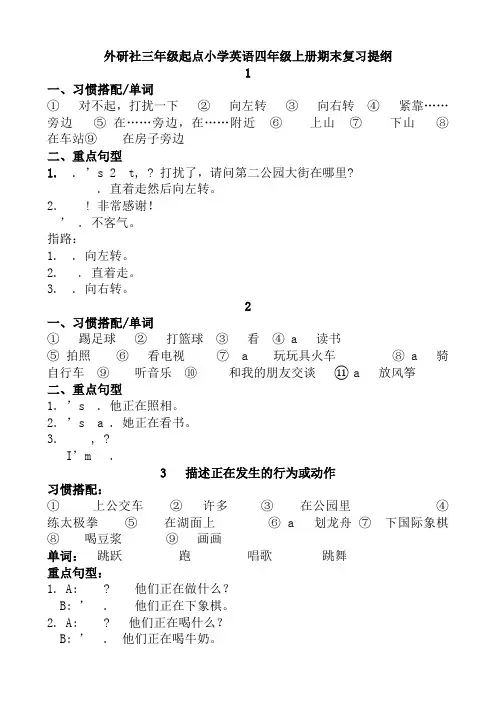
外研社三年级起点小学英语四年级上册期末复习提纲1一、习惯搭配/单词①对不起,打扰一下②向左转③向右转④紧靠……旁边⑤在……旁边,在……附近⑥上山⑦下山⑧在车站⑨在房子旁边二、重点句型1. . ’s 2 t, ? 打扰了,请问第二公园大街在哪里?. 直着走然后向左转。
2. ! 非常感谢!’ .不客气。
指路:1. . 向左转。
2. . 直着走。
3. . 向右转。
2一、习惯搭配/单词①踢足球②打篮球③看④ a 读书⑤拍照⑥看电视⑦ a 玩玩具火车⑧ a 骑自行车⑨听音乐⑩和我的朋友交谈⑪ a 放风筝二、重点句型1. ’s . 他正在照相。
2. ’s a . 她正在看书。
3. , ?I’m .3 描述正在发生的行为或动作习惯搭配:①上公交车②许多③在公园里④练太极拳⑤在湖面上⑥ a 划龙舟⑦下国际象棋⑧喝豆浆⑨画画单词:跳跃跑唱歌跳舞重点句型:1. A: ? 他们正在做什么?B: ’ . 他们正在下象棋。
2. A: ? 他们正在喝什么?B: ’ . 他们正在喝牛奶。
3. A: ’s ? 大象正在做什么?B: ’s . 它正在画图画。
3. A: ? 老虎们正在做什么?B: ’ . 它们正在跳跃。
4单词:想要一些果汁花帮助买短语:中式快餐制作面条…? ……多少钱?西红柿鸡蛋面土豆肉丝面包饺子重点句型:1. 谈论食物A: ? 你想要些面条吗?B: , . 好的。
A: ? 你想要些牛奶吗?B: , . 不,谢谢。
2. 购物A: ? 多少钱?B: ’s . 一元钱。
3. A: . 给你。
B: . 谢谢。
5单词:获胜者’t 不能,不会滑冰强壮的高的短语:跑得快跳得高跳得远骑得快重点句型:1. 谈论能力:A: ? 你跑的快吗?B: , I . 是的,我能。
2. A: ? 你跳的高吗?B: , I ’t. 不,我不能。
3. A: ? 会踢足球吗?B: , . / , ’t. 是的,他会。
/不,他不会。
4. I’m I ’t. 恐怕我不行。
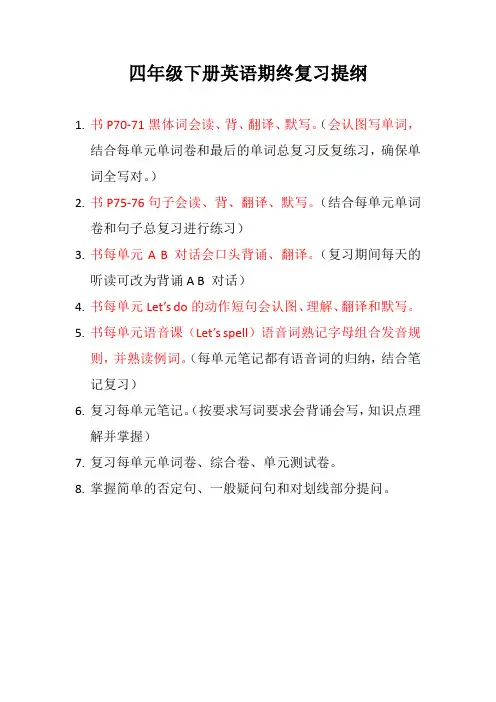
四年级下册英语期终复习提纲
1.书P70-71黑体词会读、背、翻译、默写。
(会认图写单词,
结合每单元单词卷和最后的单词总复习反复练习,确保单词全写对。
)
2.书P75-76句子会读、背、翻译、默写。
(结合每单元单词
卷和句子总复习进行练习)
3.书每单元A B 对话会口头背诵、翻译。
(复习期间每天的
听读可改为背诵A B 对话)
4.书每单元Let’s do的动作短句会认图、理解、翻译和默写。
5.书每单元语音课(Let’s spell)语音词熟记字母组合发音规
则,并熟读例词。
(每单元笔记都有语音词的归纳,结合笔记复习)
6.复习每单元笔记。
(按要求写词要求会背诵会写,知识点理
解并掌握)
7.复习每单元单词卷、综合卷、单元测试卷。
8.掌握简单的否定句、一般疑问句和对划线部分提问。
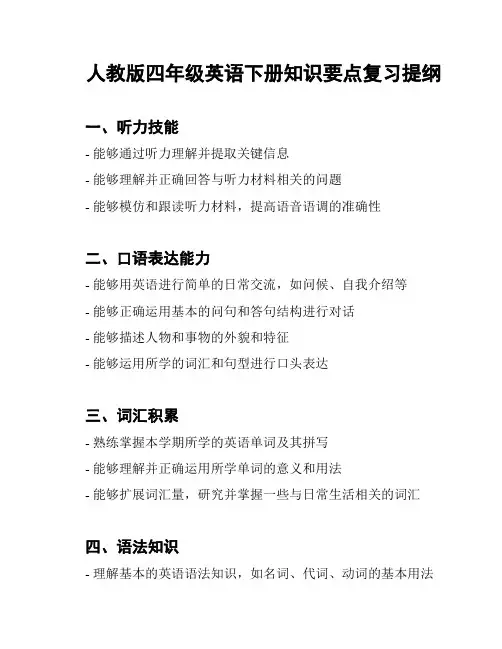
人教版四年级英语下册知识要点复习提纲
一、听力技能
- 能够通过听力理解并提取关键信息
- 能够理解并正确回答与听力材料相关的问题
- 能够模仿和跟读听力材料,提高语音语调的准确性
二、口语表达能力
- 能够用英语进行简单的日常交流,如问候、自我介绍等
- 能够正确运用基本的问句和答句结构进行对话
- 能够描述人物和事物的外貌和特征
- 能够运用所学的词汇和句型进行口头表达
三、词汇积累
- 熟练掌握本学期所学的英语单词及其拼写
- 能够理解并正确运用所学单词的意义和用法
- 能够扩展词汇量,研究并掌握一些与日常生活相关的词汇
四、语法知识
- 理解基本的英语语法知识,如名词、代词、动词的基本用法
- 能够正确运用一般现在时、一般过去时、现在进行时等基本时态
- 能够正确使用各类基本句型,如肯定句、否定句和疑问句
五、阅读理解能力
- 能够通过阅读理解文章并提取关键信息
- 能够回答与阅读材料相关的问题
- 能够理解并运用课文中的句子和语段
六、写作能力
- 能够运用所学词汇和句型进行简单的英语写作
- 能够描述人物、动物和事物的外貌、特征和活动等
以上是人教版四年级英语下册的知识要点复习提纲,通过复习这些内容,将有助于提高学生的听说读写能力,达到更好的学习效果。
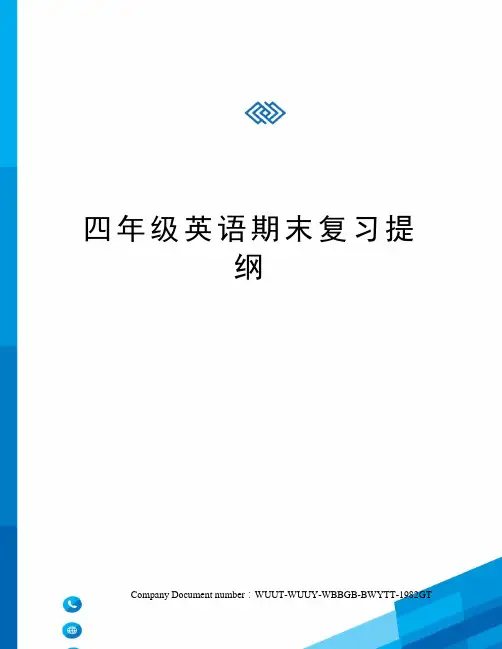
四年级英语期末复习提纲Company Document number:WUUT-WUUY-WBBGB-BWYTT-1982GT四年级英语期末复习提纲单词星期:Monday Tuesday Wednesday Thursday Friday Saturday Sunday 三餐:breakfast lunch dinner(supper)时段:morning afternoon evening night频率:always usually often sometimes never天气:fine sunny cloudy rainy snowy windy hot warm cool cold数字:one two three four five six seven eight nine ten eleven twelve fifteen thirty forty-five twenty forty fifty科目:math Chinese English music art science .词组have to 不得不;必须go to school 去上学every day 每天go to the ……去……come back 回来play with 和……玩help……帮助……have classes 上课have …class 上……课play football 踢足球play the violin 拉小提琴play the piano 弹钢琴go swimming 去游泳go shopping 去购物watch TV 看电视do homework 做作业visit ……看望……English corner 英语角from…to…从……到……at home 在家wait for 等待……be late/early for ……晚了/早了go home 回家on time 准时between…and…在…和…之间in the morning 在早上in the afternoon 在下午in the evening 在晚上at night 在夜间eat(have) breakfast 吃早饭eat(have) lunch 吃午饭eat(have) dinner 吃晚饭read a book 看书read storybooks 看故事书read newspapers 看报纸get up 起床go to bed 上床睡觉get home 到家go to a movie 去看电影enough time/money 足够的时间/钱a good idea 一个好主意far away 遥远by bus/ take a bus 乘公共汽车by car 乘小汽车by bike/ ride a bike 骑车on foot 走路;步行be(am, is, are) going to 打算;将要ride a horse 骑马weather report 天气预报stay at home 呆在家see a movie 看电影watch a video 看录像paint a picture 画画look for 寻找in the sky 在天空中turn left/right 向左/右转clean the room 打扫房间语音(要求能够挑出发音不同的单词;看图片填出阴影部分的字母组合)unit7 字母组合ou和ow (见书上第8页)特殊:touch enough tomorrow slow knowunit8 字母组合oi和oy (见书上第20页)unit9 字母组合or和oor(见书上第32页)unit10 字母组合air、ear和are(见书上第44页)特殊:heart early learn are earunit11 字母组合oo(见书上第56页)句型(划线的单词或词组表示可以替换)What do you/they do on Monday(你/他们星期一干什么)I/They go to school on Monday. (我/他们星期一去上学。
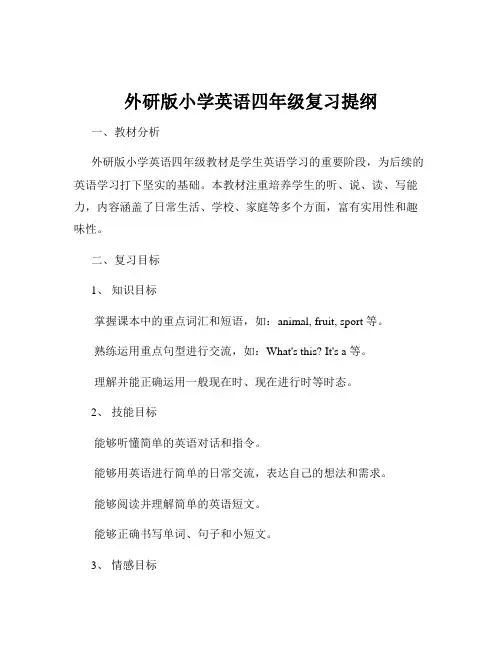
外研版小学英语四年级复习提纲一、教材分析外研版小学英语四年级教材是学生英语学习的重要阶段,为后续的英语学习打下坚实的基础。
本教材注重培养学生的听、说、读、写能力,内容涵盖了日常生活、学校、家庭等多个方面,富有实用性和趣味性。
二、复习目标1、知识目标掌握课本中的重点词汇和短语,如:animal, fruit, sport 等。
熟练运用重点句型进行交流,如:What's this? It's a 等。
理解并能正确运用一般现在时、现在进行时等时态。
2、技能目标能够听懂简单的英语对话和指令。
能够用英语进行简单的日常交流,表达自己的想法和需求。
能够阅读并理解简单的英语短文。
能够正确书写单词、句子和小短文。
3、情感目标培养学生对英语学习的兴趣和积极性。
增强学生学习英语的自信心,敢于开口说英语。
三、复习内容1、词汇动物类:cat, dog, pig, duck 等。
水果类:apple, banana, orange, grape 等。
颜色类:red, blue, green, yellow 等。
数字类:one, two, three, four 等。
家庭成员类:father, mother, brother, sister 等。
动词短语:play football, watch TV, read a book 等。
2、句型询问物品:What's this? What are these?介绍物品:It's a They're询问颜色:What colour is it?描述喜好:I like I don't like询问数量:How many?介绍人物:This is my3、语法一般现在时:主语+动词原形/第三人称单数形式。
现在进行时:主语+ be 动词+动词 ing 形式。
4、阅读理解培养学生阅读短文的能力,理解短文的大意,抓住关键信息。
学习根据上下文猜测生词的意思。
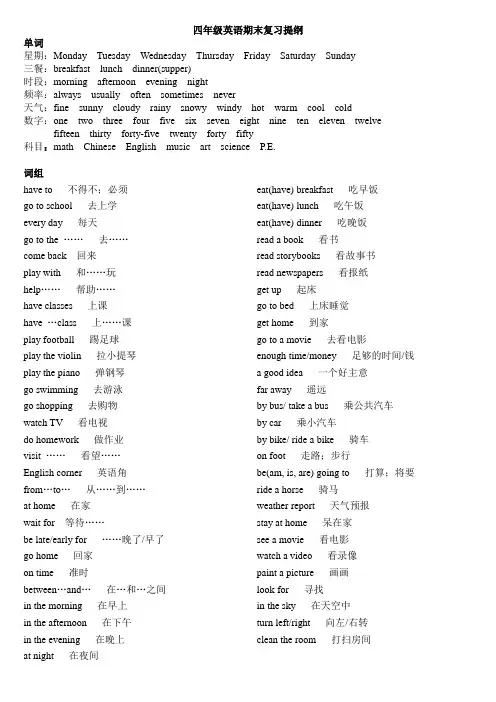
四年级英语期末复习提纲单词星期:Monday Tuesday Wednesday Thursday Friday Saturday Sunday三餐:breakfast lunch dinner(supper)时段:morning afternoon evening night频率:always usually often sometimes never天气:fine sunny cloudy rainy snowy windy hot warm cool cold数字:one two three four five six seven eight nine ten eleven twelve fifteen thirty forty-five twenty forty fifty科目:math Chinese English music art science P.E.词组have to 不得不;必须go to school 去上学every day 每天go to the ……去……come back 回来play with 和……玩help……帮助……have classes 上课have …class 上……课play football 踢足球play the violin 拉小提琴play the piano 弹钢琴go swimming 去游泳go shopping 去购物watch TV 看电视do homework 做作业visit ……看望……English corner 英语角from…to…从……到……at home 在家wait for 等待……be late/early for ……晚了/早了go home 回家on time 准时between…and…在…和…之间in the morning 在早上in the afternoon 在下午in the evening 在晚上at night 在夜间eat(have) breakfast 吃早饭eat(have) lunch 吃午饭eat(have) dinner 吃晚饭read a book 看书read storybooks 看故事书read newspapers 看报纸get up 起床go to bed 上床睡觉get home 到家go to a movie 去看电影enough time/money 足够的时间/钱a good idea 一个好主意far away 遥远by bus/ take a bus 乘公共汽车by car 乘小汽车by bike/ ride a bike 骑车on foot 走路;步行be(am, is, are) going to 打算;将要ride a horse 骑马weather report 天气预报stay at home 呆在家see a movie 看电影watch a video 看录像paint a picture 画画look for 寻找in the sky 在天空中turn left/right 向左/右转clean the room 打扫房间语音(要求能够挑出发音不同的单词;看图片填出阴影部分的字母组合)unit7 字母组合ou和ow (见书上第8页)特殊:touch enough tomorrow slow knowunit8 字母组合oi和oy (见书上第20页)unit9 字母组合or和oor(见书上第32页)unit10 字母组合air、ear和are(见书上第44页)特殊:heart early learn are earunit11 字母组合oo(见书上第56页)句型(划线的单词或词组表示可以替换)What do you/they do on Monday?(你/他们星期一干什么?)I/They go to school on Monday. (我/他们星期一去上学。
北京版小学英语四年级下册复习提纲
UNIT 1 Do you like music? 你喜欢音乐吗?重点:·询问对方是否喜欢某物的句型
·表达自己喜欢做某事的句型
难点:•询问原因
•do的用法
UNIT 2 What’s wrong with you? 你怎么了?重点:•询问对方怎么了的句子
•询问某人是否得了什么病的句子
难点:•能够在情景中用“What’s wrong / What’s the matter with…?”
UNIT 3 Can you tell me the way? 你能告诉我路线吗?重点:•如何给他人指路
•询问在哪里能找到某地点的句型
•询问去某地的路线的句型
难点:•辨析Excuse me. 和Sorry.区别
UNIT 5 Is May Day a holiday? 劳动节是一个节日吗?重点:•询问某人在将来的某天将要做什么的句型
•询问某人在某天做什么的句型
难点:•表示时间的介词at ,in和on的区别
UNIT 6 Where can I fly the kite? 我能在哪里放风筝?重点:•如何告诫别人不要做某事
•询问对方自己能否做某事的句型
难点:•祈使句的类型
UNIT 7 What happened to the floor? 地板怎么了?重点:•用于表达歉意的句子
•描述某人看起来怎么样的句子
难点:•含有实意动词的一般过去时的肯定句。
2024四年级英语知识点及复习提纲
一、语音与发音
1.英语26个字母的名称及发音;
2.元音字母的发音及拼读规则;
3.辅音字母的发音及拼读规则;
4.拼读和发音练习。
二、单词拼写
1.常见的高频单词拼写;
2.单词拼写时的注意事项;
3.练习单词拼写的方法。
三、句型和语法
1.句子成分及其搭配;
2.现在进行时、一般现在时、一般过去时的用法;
3.祈使句的构成和用法;
4.有关数量的表达方式;
5.练习句型和语法的方法。
四、基础词汇和短语
1.日常生活用语及常用短语;
2.动物、植物、水果、蔬菜名称等基础词汇;
3.表示颜色、形状、大小等形容词词汇;
4.有关时间和日期的词汇;
5.练习基础词汇和短语的方法。
五、阅读理解
1.基础阅读理解技巧(如:寻找关键词、预测内容等);
2.对话、短文、图画故事的阅读理解练习;
3.阅读材料的理解和归纳能力;
4.练习阅读理解的方法。
六、听力和口语
1.日常对话和句子的听力练习;
2.常见情景下的口语表达;
3.意见、建议和请求的表达方式;
4.练习听力和口语的方法。
七、写作技巧
1.简单的对话、日记、便条、小广告的写作;
2.句子的结构和词汇的运用;
3.表达感情和描述事物的方式;
4.练习写作技巧的方法。
以上是2024年四年级英语知识点及复习提纲,希望同学们在学习过程中能够按照提纲逐步复习,提高英语学习成绩。
闽教版四年级英语上册期末复习提纲Unit1~Unit3一、单词复习Unit1classroom教室look看class班级grade年级blackboard黑板desk书桌chair椅子Unit2turn on打开(电器)turn off关(电器)open开(门窗)close关(门窗)fan电风扇hot热的school学校sweep打扫Unit3thirteen十三thirty三十fourteen十四forty四十fifteen十五fifty五十sixteen十六sixty六十seventeen十七seventy七十eighteen十八eighty八十nineteen十九ninety九十twenty二十a hundred一百二、词组复习Unit1Class One,Grade Four四年一班(四个大头,两间房)a desk/desks一张桌子/(许多)桌子Unit2on duty值日turn on the light开灯turn on the fan开风扇close the door关门turn off the light and fan关灯和风扇close the windows关窗sweep the floor扫地clean the blackboard擦黑板Unit3NumberThirteen三、句子复习We are in Grade Four now。
Point to the blackboard。
What class are you in?I’m in Class Two,Grade Three.Are you in Class Two,Grade Two?Yes,I am/No,I’m not.Are you on duty today?Yes,I am/No,I’m not.Who’s on duty today?Li Hong and Sally.=Who is on duty today?Number Thirteen and Number Fourteen. Sally and Li Hong are on duty today.Please turn on the light/fan.All right.Please turn off the light and fan.All right.Li Hong is sweeping the floor.How much is it?It’s fifty-eight yuan.=How much is the sweater?Unit4~Unit6一、单词复习Unit4cl o ck钟o’cl o ck_________cl o se_________ when什么时候who______what________how________ home家cl o sebed床Unit5meals三餐have吃breakfast早餐lunch午餐dinner晚餐rice米饭vegetables蔬菜fish鱼bread面包milk牛奶egg蛋cake蛋糕Unit6weather天气sunny晴朗的sun太阳cloudy多云的cloud云rainy下雨的rain雨snowy下雪的snow雪cold冷的cool________warm________hot_________二、词组复习1、时间的表达ten o’clock整点ten fifteen十五分ten thirty半点ten forty-five四十五分2、行为get up起床go to school去上学go home回家go to bed睡觉在几点几分做什么事要用at,如:I go to school at seven fifteen.3、就餐have breakfastlunchdinnerhave some fishrice and fishV egetables4.take an umbrella带一把伞an_____________a____________5.have some fish吃一些鱼6.sh oe s鞋T-sh ir t T恤衫Sh or ts短裤三、句子复习1、What’s the time?It’s ten o’clock.(十点整).几点了?/ten fifteen(十点十五分)./ten thirty(十点半)./ten forty-five(十点四十五分).2、When do you get up?I get up at six thirty.你几点起床?我六点三十起床。
第一模块重点句型和短语:一、短语1、my friends 我的朋友们2、a nice teacher 一位友善的老师3、a bit shy 有一点儿害羞4、a clever pupil 一个聪明的小学生5、a very naughty bird 一只非常淘气的鸟儿6、my big brother我的大兄弟(哥哥)7、my little sister我的小妹妹8. answer the call 接电话二、句型1、This is Maomao.She is very nice.这是毛毛,他非常友好。
【向别人介绍某人,用“This is+某人”句型。
】2、These are my friends.这些是我的朋友3、She is a bit shy.她有点害羞。
4、She is a nice teacher.她是一位友善的老师。
5、He`s a clever pupil ,he is very naughty. 他是一个小学生,他(很)淘气。
6、This is my big brother,he is cool. 这是我的大哥哥,他是酷的。
7. This is my little sister ,she is cute.这是我的小妹妹,她是可爱的。
8.Can you answer the call ?你能接电话吗?第二模块重点句型和短语:一、短语1、一本关于伦敦的书 a book about London2、来自…(是…人)be from…3、白金汉宫the Buckingham Palace4、女王的房子the Queen`s house5、大本钟the Big Ben6、海德公园the Hyde Park7、塔桥the Tower Bridge 8. a big city 一个大城市9.very famous 非常著名10. Close to 靠近.....二、句型1、What`s this ? 这是什么?【其答句要用“It`s”开头的句子。
四年级英语复习提纲目录•Introduction•Unit 1: Greetings•Unit 2: Family•Unit 3: School•Unit 4: Hobbies•ConclusionIntroduction这份英语复习提纲适用于四年级学生,旨在帮助他们复习和巩固在学校里学到的英语知识。
提纲按照课本的单元划分,包括问候、家庭、学校和爱好等主题。
请注意,这份提纲只是一个指导,建议您根据您的实际情况和学生的需求进行相应的调整和补充。
Unit 1: Greetings本单元主要介绍日常问候和自我介绍的常用表达方式。
1. 问候和回答问候•Good morning!(早上好!)•Good afternoon!(下午好!)•Good evening!(晚上好!)•How are you?(你好吗?)•I’m fine, thank you.(我很好,谢谢。
)•Nice to meet you.(很高兴见到你。
)2. 自我介绍•My name is [name].(我的名字是[name]。
)•I am [age] years old.(我[age]岁。
)•I study at [school name].(我在[school name]学习。
)•My hobbies are [hobbies].(我喜欢[hobbies]。
)Unit 2: Family本单元主要介绍家庭成员和家庭关系的表达。
1. 家庭成员•father(爸爸)•mother(妈妈)•brother(哥哥)•sister(姐姐)•grandparents(祖父母)•uncle(叔叔)•aunt(阿姨)2. 家庭关系•This is my [family member].(这是我的[family member]。
)•He/She is my [family member].(他/她是我的[family member]。
)Unit 3: School本单元主要介绍学校生活和常用学习用语。
四年级英语知识点及复习提纲四年级英语知识点1. 名词可以根据意义分为普通名词和专有名词如:john is a studentstudent是普通名词,john是专有名词普通名词前可以用不定冠词a/an,定冠词the 或不加冠词,专有名词前一般不加冠词,专有名词的首字母要大写。
2. 普通名词又可以分为个体名词、集体名词、物质名词和抽象名词,其中个体名词与集体名词是可数名词,物质名词和抽象名称是不可数名词。
3. 专有名词专有名词是表示人名、地名、团体、机构、组织等的专有名词,多为独一无二的事物。
四年级英语复习知识点行为动词就是我们平时上课时说的动词,表示某一动作或行为。
如:sweep、live等。
行为动词我们已学过它们的四种形式:原形、+s/es、+ed、+ing,具体判断方法如下:↗有,就加ing读句子→读该单词→认识该单词→理解意思→看有无be动词 (若是be going to 就用原形)↘没有,再看情态动词↗有,就用原形↗有,就加ed↘没有,再看有无表示过去的时间状语↗是第三人称单数就加s或es ↘没有,再看主语↘不是第三人称单数就用原形四年级英语知识点总结规则变化1、一般情况下加-s如book--books(书)desk--desks(书桌)2、以s ,x ,ch , sh结尾加-es如box--boxes(盒子)bus--buses(公共汽车)注意①以 th 结尾加-s, month--months②stomach--stomachs3、以辅音字母+结尾,变y为i再加- es。
如city--cities(城市) country--countries(国家)注意以元音+y,直接加s。
如:day--days(天),boy--boys(男孩)4、以f或fe结尾,复数变f或 fe 为v再加-es如knife-knives(书) , half-halves(一半)(thief ,wife ,life ,shelf ,knife ,leaf ,self ,half ,wolf) 注意①有少数词后直接加s,如roof-roofs (屋顶)5、以o结尾(1)辅音字母加o结尾名词的加-es如tomato-tomatoes(西红杮)potato-potatoes(土豆)(2) 元音字母加o结尾名词的加-s如piano-pianos (钢琴), zoo-zoos(动物园)photo-photos (照片), kangaroo-kangaroos(袋鼠)kilo-kilos(千克)注意zero 两种方式都可:zero-zeros或 zeroes(零)。
四年级英语复习提纲
Unit 1:
1、—Where is my new cap? 我的新帽子在那里?
— It is in the cupboard. 在柜厨里
2、—Where are my glasses? 我的眼镜在哪里?
—They are on your head. 在你的头上。
Unit 2:
1、He can read. 他会读。
2、She can't fly. 她不会飞。
3、—Can you write in English?你能用英语写吗?
—Y es , I can. 是的,我能
—No, I can’t. 不,我不能。
Unit 3:
1.—Are you making a kite?你在做风筝吗?
—Y es, I am.是的
—No, I’m not.不是。
2.— What are you doing ? 你在做什么?
—I am playing the piano.我在弹钢琴。
3.—What is Anne doing ? Anne在做什么?
—She is baking a cake.她在做蛋糕。
Unit 4:
1. Peter is writing. Peter正在写字。
2.My mother is sweeping. 我的妈妈在扫地。
3.I am sleeping. 我在睡觉
4.Y ou are painting. 你在画画
Unit 5:
1.—What is Anne doing? Anne正在干什么?
—She is skipping. 她正在跳绳
2.—What is Peter doing ? 皮特在做什么?
—He is climbing. 她正在爬山
3.—What is the girl doing ? 那个女孩在做什么?
—She is hopping. 她正在单足跳.
4. —What are you doing ? 你在做什么?
—I am skipping. 我在单足跳。
Y ou are dancing. 你在跳舞。
Unit 6:
1.—Where are you going? 你要去哪里?
—I’m going to school. 我正要去学校
2.—Where is she going? 她要去哪里?
—I’m going to school. 她正要去邮局。
Unit 7:
1.—What day is it today? 今天星期几?
—Today is Sunday. =It’s Sunday today. 今天星期天
2.—What day is it tomorrow? 明天星期几?
— Tomorrow is Monday。
= It’s Monday tomorrow. 明天星期一
3.Peter is happy today. Peter今天很高兴。
4.I am happy today. 我今天很高兴。
5.Y ou are happy today. 你今天很高兴。
Unit 8:
1.—What’s the weather like today/tomorrow? 今天天气怎样?
—It’s cold. 天气很冷。
2.—What’s the weather like in spring? 秋天天气怎样?
—It’s cool. 天气很凉爽
3—What’s the weather like on Monday ? 星期一天气怎样?
—It’s hot. 天气很热。
4. I like spring.我喜欢春天。
5. Spring is warm and nice.=It is warm and nice in Spring春天温暖而美好。
Unit 9:
1.—Where are you from? 你来自哪里?
—I come from Australia 我来自澳大利亚。
—I’m from China 我来自中国。
2.—Where is he from? 他来自哪里?
— He is from India.= He comes from India. 他来自印度。
3.Y ou are from America. = Y ou come from America. 你来自美国。
Unit 10:
1.—How much is the apple? 苹果多少钱?
—It’s three yuan.3元钱。
1.—How much are the books? 这些书多少钱?
—They are ten yuan. 10元钱。
Unit 11:
1. I have a puppet. 我有一个木偶。
2. Y ou have a book。
你有一本书
3. She has two feet. 她有2只脚
4.—How many teeth do you have? 你有多少颗牙齿?
—I have sixteen teeth. 我有16颗牙齿。
Unit 12:
1.—Do you have a ticket? =Have you got a ticket? 你有一张票吗?
—Y es ,I have. 是的,我有。
—No , I haven’t. 不,我没有。
2.—What do you have? 你有什么?
—I have a lollipop ? 我有一个棒棒糖。
动词的—ing形式
第一类:
cook—cooking paint—painting sleep—sleeping
sweep— sweeping climb—climbing walk—walking
go—going play — playing work—working
第二类:
make—making bake—baking write—writing dance—dancing come—coming
第三类:
hop—hopping skip—skipping run—running swim—swimming dig—digging。